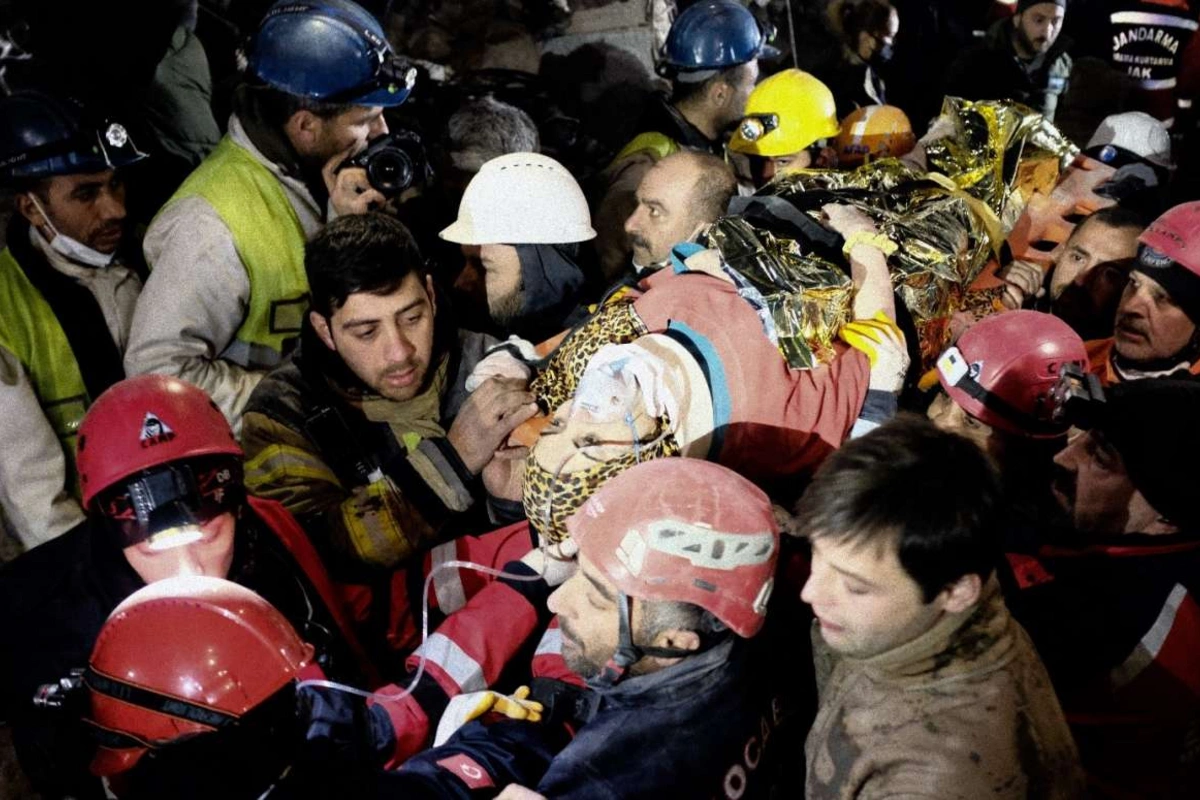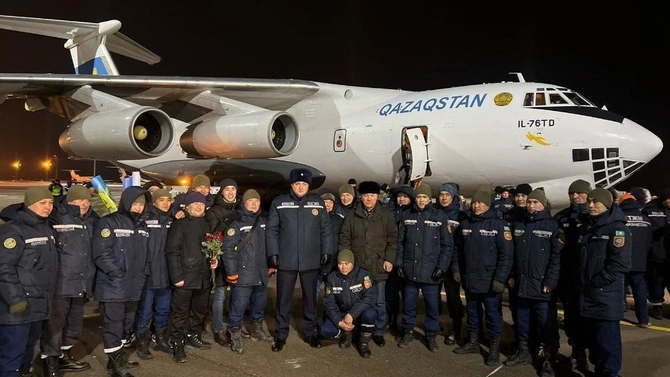
The terrible quakes in Turkiye and Syria galvanized over 100 nations to send helpers and aid, including all ten countries of the Caspian Region.
15-year-old Syrian Seher, extracted from under the rubble by rescue teams 208 hours later, in Hatay, Turkey, on February 14, 2023. Image: Umit Turhan/NurPhoto
It has been over 20 days since two severe earthquakes struck South Eastern Turkiye and Northern Syria, claiming over 50,000 lives. In Turkiye alone, the quakes affected around 20 million people in ten provinces,[1] with roughly two and a half times as many deaths as in 1999, when 17,500 people lost their lives in the Istanbul earthquake.
“I lost more than 20 relatives,” Ali Bayındır, a UK-based Turkish researcher, told the Caspian Post. “My sister lives in Hatay [near the Syrian border]. She helped to sort out incoming food, clothes and aid at a local sports centre and tried to make sure it reached the earthquake survivors.”
It was in Hatay that a mother and her two children were rescued from the rubble after nearly 10 days in one of several remarkable stories that offered glimmers of hope. The challenges facing the country, however, are immense. In addition to the devastating human cost of the disaster, a report published by the Turkish Enterprise and Business Confederation has put the expected financial cost of the damage, including repairs, at a staggering $84.1 billion.

Nonetheless, many countries have made gestures of friendship, and relief efforts have been truly international. According to February 18 figures from the Turkish Foreign Ministry, over 100 countries offered to assist in Turkiye’s affected areas, with thousands of foreign personnel being deployed.
All ten countries of the Caspian region stepped up to help survivors. Here’s how:
Azerbaijan led the way in supporting Turkiye. A force of at least 370 Azerbaijani search and rescue workers, assisted by several rescue dogs, was the first foreign team to arrive in the country, just 15 hours after the first earthquake hit.
Baku later sent more support, bringing the total number of Azerbaijani personnel to 867, including rescuers, doctors, psychologists and other specialists, more than any other country.

The team was deployed to the quake’s epicentre, Kahramanmaraş. On February 9, they were credited with having rescued at least 44 people, nine of whom were children, performing ten surgical procedures, examining 98 survivors and recovering 164 bodies.
Many private citizens made donations of their own. One little boy warmed hearts by donating a coat with pockets filled with sweets and nuts for its new Turkish owner. Another Azerbaijani construction worker Sarvar Bashirli went viral after overloading his old Soviet car – a car nine years his senior – to deliver aid, including bedding made by his grandmother. On February 27, reports showed the Turkish Foreign Minister Mevlut Cavusoglu personally meeting Azerbaijani volunteers in Kahramanmaraş. Small businesses also put aside part of their profits to fund the “White Helmet” helpers in Syria.
“Everyone tried to help as much and as quickly as possible. Among the donors, you could see representatives of all segments of the population, from schoolchildren donating their pocket money to retirees transferring their pensions in full to the survivors,” the Azerbaijani parliamentarian Javanshir Feyziyev told the Caspian Post. “Every Azerbaijani perceives this catastrophe as his personal tragedy.”
Turkiye’s other two South Caucasus neighbours, Georgia and Armenia, also supported relief efforts. Georgia deployed 100 personnel, including 60 rescue workers, who saved a person in Adıyaman, with a further 40 firefighters sent to assist. Tbilisi donated 100 tons of humanitarian support, including medical supplies, food, warm clothing, generators, tents and sleeping bags.

Armenia’s assistance to Turkiye was perhaps one of the most striking interventions from the Caspian region. To put it very lightly, relations between the two countries have been less than cordial for decades. Yet Yerevan made a gesture of friendship, initially sending 27 rescue workers to Turkiye (plus 29 to Syria) and later upping this to 57. In another noteworthy turn of events, the Turkish-Armenian border was opened for the first time in around thirty years to allow Armenian trucks to deliver humanitarian supplies to the affected areas. “Let's get some good out of this great disaster. Solidarity saves lives!” tweeted Garo Paylan, a Turkish opposition MP of Armenian heritage who’s a keen supporter of normalization between the two countries.
Rescue workers from Central Asian states made important impacts in Kahramanmaraş. A combined Turkish and Kazakh team pulled a woman out of the debris alive after 158 hours, Tajik rescuers pulled free a 3-year-old toddler, and a 150-strong Kyrgyz team saved a teenage boy, a 7-year-old and a pregnant woman. A joint Kyrgyz, Russian and Belarusian crew also saved a man after 160 hours under a collapsed building

Kyrgyzstan and Kazakhstan donated 84 yurts (woollen tents) to provide safe and warm temporary accommodation - a powerful display of fraternal, cultural solidarity between countries with Turkic nomadic roots.
In Hatay, over 100 Uzbek rescuers worked to save at least thirteen people, and Tashkent topped up their support with a plane load of specialist gear, medicines and emergency equipment. Turkmenistan made a similar gesture, flying in humanitarian supplies, including 1500 blankets and ten generators, while the Turkmen-Turkish Commercial Bank opened a charitable foreign currency bank account for donations.
In addition to sending a team to Turkiye, Russia deployed over 300 soldiers to assist the rescue operations in Syria, where Moscow has good relations with the otherwise internationally shunned Assad regime. Iran has provided support to both Ankara and Damascus. The day after the quakes, Tehran sent six search and rescue groups, three health specialist teams, and an emergency situation group totalling 80 people and several dogs. A further 46 Iranian medical specialists were sent to Adana and Gaziantep. Tehran also sent Turkiye several planes full of humanitarian aid, while the Iranian Red Crescent Society set up field hospitals in both countries.
All in all, the countries of the Caspian region played a noteworthy role in providing urgent and vital relief to the survivors of the most devastating earthquakes to hit the region in over twenty years.
[1] Adana, Adıyaman, Diyarbakır, Gaziantep, Hatay, Kahramanmaraş, Kilis, Malatya, Osmaniye, and Şanlıurfa
Share on social media